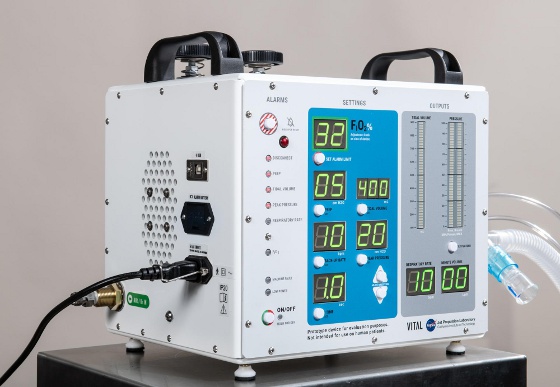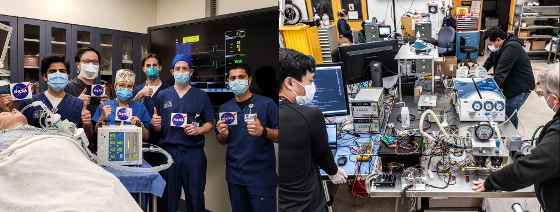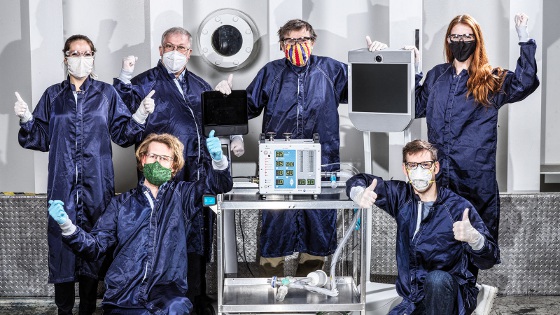 |
| May 05, 2020 | Volume 16 Issue 17 |
Designfax weekly eMagazine
Archives
Partners
Manufacturing Center
Product Spotlight
Modern Applications News
Metalworking Ideas For
Today's Job Shops
Tooling and Production
Strategies for large
metalworking plants
NASA develops ventilator in 37 days, gets emergency FDA approval

NASA's Jet Propulsion Laboratory in Southern California designed and built this ventilator prototype for coronavirus patients in just over a month's time. [Credit: NASA/JPL-Caltech]
A new high-pressure ventilator developed by NASA engineers and tailored to treat coronavirus (COVID-19) patients was approved April 30 by the Food and Drug Administration (FDA) for use under the FDA's March 24 ventilator Emergency Use Authorization.
Called VITAL (Ventilator Intervention Technology Accessible Locally), the device was developed by engineers at NASA's Jet Propulsion Laboratory (JPL) in Southern California to free up the nation's limited supply of traditional ventilators so they may be used on patients with the most severe COVID-19 symptoms.
"We specialize in spacecraft, not medical-device manufacturing," said JPL Director Michael Watkins. "But excellent engineering, rigorous testing, and rapid prototyping are some of our specialties. When people at JPL realized they might have what it takes to support the medical community and the broader community, they felt it was their duty to share their ingenuity, expertise, and drive."

At left, doctors at the Icahn School of Medicine at Mount Sinai in New York City give a thumbs up after testing a ventilator prototype developed by NASA's Jet Propulsion Laboratory in Southern California. At right, JPL engineers work on the ventilator prototype for coronavirus patients. [Credit: Icahn School of Medicine at Mount Sinai, New York City, and NASA/JPL-Caltech]
The Office of Technology Transfer and Corporate Partnerships at Caltech, which manages JPL for NASA, is offering a free license for VITAL and is reaching out to the commercial medical industry to find manufacturers for the device.
"Now that we have a design, we're working to pass the baton to the medical community, and ultimately patients, as quickly as possible," said Fred Farina, chief innovation and corporate partnerships officer at Caltech. "To that end, we are offering the designs for licensing on a royalty-free basis during the time of the pandemic."

Some of the dozens of engineers involved in creating the ventilator prototype specially targeted to treating coronavirus disease patients. They are shown at NASA's Jet Propulsion Laboratory. [Credit: NASA/JPL-Caltech]
The Emergency Use Authorization allows for use of the device specifically for COVID-19 patients, with the aim of addressing the acute demand for ventilators during the coronavirus pandemic. Like all ventilators, VITAL requires patients to be sedated and have an oxygen tube inserted into their airway to breathe.
Prior to the FDA's review, the VITAL prototype passed a critical test April 21 at the Icahn School of Medicine at Mount Sinai in New York. VITAL provides several benefits in the national response to COVID-19. It can be built faster and maintained more easily than a traditional ventilator, and it is composed of far fewer parts, many of which are currently available to potential manufacturers through existing supply chains.
VITAL's flexible design means it also can be modified for use in field hospitals being set up in convention centers, hotels, and other high-capacity facilities across the country and around the globe. Intended to last three or four months, the new device wouldn't replace current hospital ventilators, which can last years and are built to address a broader range of medical issues.
"It's been exhilarating coming up with VITAL's design," said Michelle Easter, a mechatronics engineer at JPL who worked on developing the device. "Now that we have FDA approval, we're looking forward to seeing companies license this technology and share it with the rest of the world."
Source: NASA JPL
Published May 2020
Rate this article
View our terms of use and privacy policy
